
Staff Selection Commission (SSC) Stenographer Recruitment Examination Held on July 31, 2016
Part I Reasoning
Directions (Q. Nos. 1-9) Select the related word/letter/number from the given alternatives.
1. Prediction : Future : : Regret : ?
(a) Past
(b) Present
(c) Sin
(d) Time
2. Adversary : Enemy : : Adversity : ?
(a) Friend
(b) Dynamic
(c) Love
(d) Difficulty
3. Bird : Worm :: ?
(a) Horse : Stable
(b) Trap : Cheese
(c) Lion : Cave
(d) Cat : Mouse
4. MAD : JXA : : RUN : ?
(a) OSQ
(b) PRJ
(c) UXQ
(d) ORK
5. BEGK: ADFJ:: PSVY: ?
(a) ORUX
(b) ROUX
(c) LQUT
(d) LOQT
6. AZBY: CXDW : : EVFU : ?
(a) GHTS
(b) TGSH
(c) GTHS
(d) GSTH
7. 42 : 20 : : 64 : ?
(a) 31
(b) 32
(c) 33
(d) 34
8. 6 : 18 : : : 4 : ?
(a) 6
(b) 8
(c) 10
(d) 14
9. 8 : 24 : : ? : 32
(a) 5
(b) 6
(c) 10
(d) 8
Directions (Q. Nos. 10-18) Find the odd word/letters/number/number pair from the given alternatives.
10.
(a) Tired
(b) Tardy
(c) Slow
(d) Late
11.
(a) Agitation
(b) Confusion
(c) Commotion
(d) Annihilation
12.
(a) Pen : Stationery
(b) Earth : Moon
(c) Sun: Star
(d) Painter : Artist
13.
(a) EDC
(b) MLK
(c) NPR
(d) XWV
14.
(a) MOQS
(b) ZADE
(c) CEGI
(d) SUWY
15.
(a) NILE
(b) LIEN
(c) LINE
(d) LEAN
16.
(a) 78
(b) 91
(c) 84
(d) 26
17.
(a) 48
(b) 96
(c) 59
(d) 12
18.
(a) 16-32
(b) 19-38
(c) 21-40
(d) 23-46
19. Which one of the given responses would be a meaningful order of the following words in ascending order?
1. Probation 2. Interview
3. Selection 4. Appointment
5. Advertisement
(a) 5, 2, 3, 4, 1
(b) 5, 3, 2, 1, 4
(c) 5, 4, 2, 3, 1
(d) 4, 5, 1, 2, 3
20. Arrange the words given below in a meaningful sequence :
1. Printer 2. Publisher
3. Writer 4. Editor
5. Seller
(a) 2, 3, 4, 1, 5
(b) 3, 4, 2, 1, 5
(c) 3, 4, 1, 2, 5
(d) 2, 4, 3, 5, 1
21. Which of the following words will come fourth, if arranged according to the English dictionary?
(a) Rain
(b) Reef
(c) Ready
(d) Rainbow
Directions (Q. Nos. 22-26) A series is given, with one term missing. Choose the correct alternative from the given ones that will complete the series.
22. ACE, GIK, MOQ, ?
(a) RTU
(b) SUW
(c) UVW
(d) STV
23. LMnP, PQrT, TUvX, ?
(a) VWnP
(b) PRsT
(c) UVwY
(d) XYzB
24. 826, 480, 346, 134, ?
(a) 83
(b) 61
(c) 212
(d) 126
25. 78, 155, 309, ?, 1233
(a) 625
(b) 1230
(c) 1000
(d) 617
26. 5, 8, 16, 19, 38, 41, ?
(a) 44
(b) 80
(c) 40
(d) 82
27. Which one set of letters when sequentially placed at the gaps in the given letter series shall complete it?
h_t_l_tt_lht_m_htt_l
(a) m m h t l t m
(b) h m m t t l m
(c) t m h m t l m
(d) l m t m h m t
28. A and B is a married couple. C and D are brothers. C is the brother of A. How is D related to B?
(a) Brother-in-law
(b) Brother
(c) Son-in-law
(d) Cousin
29. The average age of the present ages of Amit and Anil is 32 years. If Amit is 6 years older than Anil, then what is Anil’s present age?
(a) 29 yr
(b) 38 yr
(c) 26 yr
(d) 19 yr
30. From the given alternatives, select the word which cannot be formed using the letters of the given word.
JURISPRUDENCE
(a) PREJUDICE
(b) PRINCE
(c) PRUNE
(d) PRESIDENT
31. From the given alternative words, select the word which can be formed using the letters of the given word.
MONUMENT
(a) TENENT
(b) TENT
(c) MOUNT
(d) MOVEMENT
32. If in a certain code, DIAGRAM is written as AFXDOXJ, then how can PICTURE be written in that code?
(a) NGARSPC
(b) MGAQRPB
(c) NFYQROC
(d) MFZQROB
33. If ABLE is written as 5324 and BINGO is written as 36178, then BANGLE can be written as
(a) 351724
(b) 356724
(c) 321846
(d) 362417
34. If ‘+’ stands for ÷; ‘×’ stands for +; ‘−’ stands for ×, ‘÷’ stands for −, then which of the following equations is correct?
(a) 33 – 4 ÷ 5 × 6 + 2 = 130
(b) 33 × 4 – 5 + 6 ÷ 2 = 26
(c) 33 ÷ 4 × 5 + 6 – 2 = 30
(d) 33 – 4 + 5 ÷ 6 × 2 = 24
35. Sonu and his friend Rahul went for shopping. Sonu had Rs. 500 with him while Rahul had Rs. 240. Sonu spent twice as much as Rahul on shopping. Now, Sonu has three times as much money as is left with Rahul. How much money did Sonu spend?
(a) Rs. 220
(b) Rs. 60
(c) Rs. 440
(d) Rs. 120
36. Which one of the following interchanges of signs would make the given equation correct?
5 + 3 × 8 – 12 ÷ 4 = 3
(a) + and −
(b) − and ÷
(c) + and ×
(d) + and ÷
37. Some equations have been solved on the basis of a certain system. Find the correct answer for the unsolved equation on that basis.
If 29 × 13 = 14, 76 × 26 = 34, then 64 × 14 = ?
(a) 54
(b) 39
(c) 32
(d) 26
Directions (Q. Nos. 38-39) Select the missing number from the given responses.
38. 121 100 ? 169
4 8 9 7
7 2 5 6
(a) 81
(b) 114
(c) 196
(d) 214
39. 1 4 9 16
1 2 3 4
2 4 6 ?
(a) 8
(b) 7
(c) 5
(d) 4
40. A girl leaves from her home. She first walks 30 m in North-West direction and then 30 m in South-West direction. Next, she walks 30 m in South-East direction. Finally, she turns towards her house. In which direction is she moving?
(a) North-East
(b) North-West
(c) South-East
(d) South-West
41. Starting from a point O, Mahesh walks a distance of 5 km South, then turns to his right and walks 3 km. From there, he again turns right and walks 5 km. .He then runs to his left and walks 5 km. How far is he from the starting point?
(a) 15 km
(b) 13 km
(c) 8 km
(d) 5 km
Directions (Q. Nos. 42-43) Two statements are given followed by two/our conclusions I, II, III and IV. You have to consider the statements to be true, even if they seem to be at variance from commonly known facts. You have to decide which of the given conclusions can definitely be drawn from the given statements. Indicate your answer.
42. Statements
All apples are oranges.
Some oranges are papayas.
Conclusions
I. Some apples are papayas.
II. Some papayas are apples.
(a) Only I follows
(b) Only II follows
(c) Both I and II follow
(d) Neither I nor II follows
43. Statements
All aeroplanes are trains.
Some trains are chairs.
Conclusions
I. Some aeroplanes are chairs.
II. Some chairs are aeroplanes.
III. Some chairs are trains.
IV. Some chairs are trains.
(a) None follows
(b) I and II follow
(c) II and III follow
(d) III and IV follow
44. How many triangles are there in the following figure?
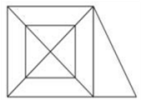
(a) 16
(b) 18
(c) 20
(d) 22
45. Which of the following figures given the proper relation to Fruit, Red and Shirt?
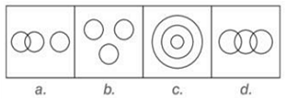
46. Which answer figure will complete the pattern in the question figure?
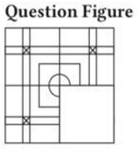

47. From the given answer figures, select the one in which the question figure is hidden/embedded.
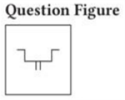
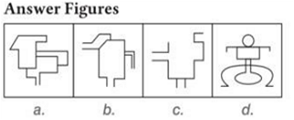
48. A piece of paper is folded and cut as shown below in the question figures. From the given answer figures, indicate how it will appear when opened
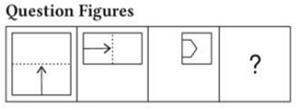

49. If a mirror is placed on the line MN, then which of the answer figures is the right image of the question figure?

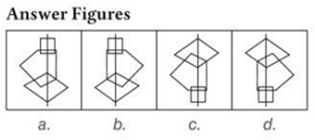
50. A word is represented by only one set of numbers as given in any one of the alternatives. The sets of numbers given in the alternatives are represented by two classes of alphabets as in the two matrices given below. The columns and rows of Matrix I are numbered from 0 to 4 and that of Matrix II are numbered from 5 to 90. A letter from these matrices can be represented first by its row and next by its column, e.g. ‘O’ can be represented by 01, 33 etc. and ‘Q’ can be represented by 55, 78 etc. Similarly, you have to identify the set for the word ‘METAL’.
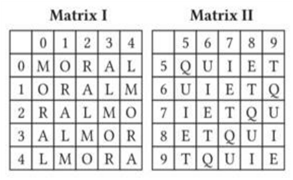
(a) 23, 67, 96, 40, 44
(b) 23, 76, 95, 40, 44
(c) 32, 76, 95, 44, 04
(d) 32, 76, 44, 95, 04
Part II General Awareness
51. The supply side measure to control inflation is
(a) credit control
(b) reducing public expenditure
(c) price control through Public Distribution System
(d) higher taxation to mop up liquidity
52. The Ability Principle of Taxation is given by
(a) JS Mill
(b) Adam Smith
(c) Edgeworth
(d) Joan Robinson
53. ‘World Economic Report’ is published by
(a) UNCTAD
(b) World Bank
(c) UNDP
(d) IMF
54. ‘Galloping inflation’ is also known as
(a) Creeping inflation
(b) Walking inflation
(c) Running inflation
(d) Hyper inflation
55. Average fixed cost curve is
(a) downward sloping
(b) Walking inflation
(c) Running inflation
(d) Hyper inflation
56. Article-368 of the Indian Constitution deals with
(a) amending procedure
(b) emergency provisions
(c) right to primary education
(d) right to information
57. Who among the following proposed the suggestion for a Constituent Assembly first in 1935?
(a) MN Roy
(b) Nehru
(c) Gandhi
(d) JP Narayan
58. According to Paul Appleby, the quality of good administrators is
(a) self-confidence
(b) intelligence
(c) integrity
(d) loyalty
59. Which of the following works of Plato is primarily a ‘treastise’ on justice?
(a) Apology
(b) Phaedo
(c) The Statesman
(d) The Republic
60. Who was referred to as the ‘Ambassador of Hindu-Muslim Unity’ by Sarojini Naidu?
(a) Maulana Azad
(b) Muhammad Ali Jinnah
(c) Abdul Ghaffar Khan
(d) Shaukat Ali
61. The capital of Yadava kings was
(a) Krishnagiri
(b) Devagiri
(c) Varanasi
(d) Kanchipuram
62. The fall of Bastille is associated with the
(a) Greek War of Independence
(b) Russian Revolution of November, 1917
(c) French Revolution of 1789
(d) American War of Independence
63. Which Governor-General was called as the ‘Father of Local Self-Government’ in India?
(a) Lord Ripon
(b) Lord Wellesley
(c) Lord Canning
(d) Lord William Bentinck
64. ‘The Three Emperor’s League’, 1873 was also known as
(a) The Dual Alliance
(b) Dreikaiserbund Treaty
(c) Triple Alliance
(d) Reinsurance Treaty
65. Panditraj Jagannath was the poet laureate of which of the following rulers?
(a) Humayun
(b) Akbar
(c) Shah Jahan
(d) Aurangzeb
66. Which of the following is formed out of volcanic eruptions in India?
(a) Himalayas
(b) Deccan Plateau
(c) Lakshadweep Islands
(d) Western Ghats
67. Terrigenous deposits are found in
(a) continental shelf and slope
(b) deep sea plain
(c) ocean trenches
(d) rift valley
68. Which of the following is the only volcanic peak in Antarctica?
(a) Mt. Cook
(b) Mt. Blanc
(c) Mt. Erebus
(d) Mt. Elbrus
69. Who laid the foundation of the ‘School of Possibilism’?
(a) Ratzel
(b) Brunches
(c) La Blache
(d) Humboldt
70. The lysimeter helps in the estimation of
(a) wind direction
(b) evapotranspiration
(c) relative humidity
(d) vapour pressure
71. Compounds that are needed for enzymes to function properly are
(a) buffers
(b) steroids
(c) vitamins
(d) heavy metals
72. Heavy water is
(a) deuterium oxide
(b) deuterium
(c) rain water
(d) tritium oxide
73. Which one of the following is commonly known as ‘Pond Silk’?
(a) Ulothrix
(b) Spirogya
(c) Rhizopus
(d) Yeast
74. ‘Gynecomastia’ is
(a) development of breasts in males
(b) development of hair on ears in males
(c) increased height in females
(d) development of an extra finger in females
75. The highest concentration of urea is found in
(a) renal vein
(b) hepatic portal vein
(c) dorsal aorta
(d) hepatic vein
76. The inert gas which is substituted for nitrogen in the air used by deep sea divers for breathing, is
(a) helium
(b) xenon
(c) krypton
(d) argon
77. Cryogenics is the study of
(a) low temperature
(b) high temperature
(c) superconductor
(d) production of fuels
78. To prevent damage from lightning, lightning conductors are sued on tall structures. The lightning conductor
(a) should be made of a good conductor, like copper with sharp pointed edges
(b) should be made of a good conductor but can be of any shape
(c) should be in the form of a vertical rod
(d) can be of any shape.
79. Infrared radiations are detected by
(a) spectrometer
(b) pyrometer
(c) nanometer
(d) photometer
80. Beta rays emitted by a radioactive material are
(a) electromagnetic radiations
(b) the electrons orbiting around the nucleus
(c) charged particles emitted by nucleus
(d) neutral particles
81. Which of the following computer memories is non-volatile?
(a) RAM
(b) DRAM
(c) SRAM
(d) ROM
82. In present day computing, which code is used and is accepted worldwide?
(a) ISCII
(b) ASCII
(c) Hollerith Code
(d) EBCDIC
83. Which of the following is the strongest base in aqueous solution?
(a) Ethylamine
(b) Diethylamine
(c) Triethylamine
(d) Ammonia
84. Which one of the following is not an artificial sweetener?
(a) Aspartame
(b) Fructose
(c) Saccharin
(d) Sucralose
85. An acid having basicity one is
(a) Phosphoric acid
(b) Sodium dihydrogen phosphate
(c) Disodium hydrogen phosphate
(d) Sodium phosphate
86. Which one of the following vegetable oils is used in the manufacture of paints?
(a) Cottonseed oil
(b) Palm oil
(c) Sunflower oil
(d) Linseed oil
87. Acid rain is caused by the pollution of environment by
(a) carbon dioxide and nitrogen
(b) carbon monoxide and carbon dioxide
(c) ozone and carbon dioxide
(d) nitrous oxide and sulphur dioxide
88. Which of the following is not a gaseous air pollutant?
(a) Oxides of sulphur
(b) Oxides of nitrogen
(c) Hydrocarbon
(d) Smoke
89. Which one of the following is called the ‘Land of One Thousand Lakes’?
(a) Finland
(b) Sweden
(c) Greenland
(d) The USA
90. The tree popularly known as ‘Green Gold’, but which is an ecological
(a) Eucalyptus
(b) Banyan
(c) Pipal
(d) None of these
91. Garampani Wildlife Sanctuary is located at
(a) Junagarh (Gujarat)
(b) Diphu (Assam)
(c) Gangtok (Sikkim)
(d) Kohim (Nagaland)
92. Who won the prestigious Gujarmal Modi Award for Innovative Science and Technology for the year 2015?
(a) Amalendu Krishna
(b) Professor Mustansir Barma
(c) GM Reddy
(d) Vivekanand Kain
93. ‘Entomology’ is the science that studies
(a) insects
(b) behaviour of human beings
(c) formation of rocks
(d) None of the above
94. Which country uses the ‘Birr’ as its currency?
(a) Estonia
(b) Ethiopia
(c) Togo
(d) Eritera
95. How many Noble Prize awards are awarded each year?
(a) 6
(b) 5
(c) 7
(d) 4
96. Wellington trophy is associated with
(a) bridge
(b) rowing
(c) Chess
(d) hockey
97. World Autism Awareness Day is observed on
(a) April 1
(b) April 2
(c) April 3
(d) April 5
98. Who invented the ‘World Wide Web’?
(a) Charles Babbage
(b) Tim Berners Lee
(c) Martin Cooper
(d) R. Samuel Tomlinson
99. The novel ‘When the river Sleeps’ is written by
(a) Easterine Kire
(b) Anuradha Roy
(c) Vikram Seth
(d) Shobha De
100. In Which country did the world’s first organized motor race occur?
(a) France
(b) Germany
(c) The USA
(d) Portugal
Part III English Language
Directions (Q. Nos. 101-110) Some parts of the sentences have errors and some are correct. Find out, which part of a sentence has an error. If a sentence is free from error, choose ‘No Error’.
101. I want to exchange (a) / my Maruti (b)/ from a Santro. (c) No error (d)
102. There were extensive (a)/ lawn in front (b)/ of the bungalow. (c) No error (d)
103. Wise men follow nobel (a)/ideas whereas fools (b)/ disregard them. (c) No error (d)
104. The navel officers (a)/ successfully fought the pirates (b)/who had looted and plundered for many years. (c) No error (d)
105. He acted no (a)/as per my advice (b)/but somebody else. (c) No error (d)
106. The chairs in the (a)/ room are in a (b)/ state disarray. (c) No error (d)
107. Ashoka the Great was (a)/ regarded one of the greatest Emperors (b)/the world has ever produced. (c) No error (d)
108. Will you please (a)/ given me little milk (b) for my cat? (c) No error (d)
109. The light bulbs (a)/ on the hall (b)/ need to be changed. (c) No error (d)
110. A recent survey indicates (a)/ that the number of drug addicts (b)/grew day by day. (c) No error (d)
Directions (Q. Nos. 111-115) Sentences are given with blanks to be filled in with an appropriate word (S). Four alternatives are suggested for each question. Choose the most appropriate alternative out of the four.
111. Do Not look ……. on women.
(a) up
(b) down
(c) right
(d) left
112. I ……. him on this point.
(a) agree to
(b) agreeing with
(c) agreed with
(d) admitted to
113. The stranger ……… in through the window last night.
(a) creeps
(b) creep
(c) crept
(d) creeping
114. They ……. living here since 2000.
(a) are still
(b) have been
(c) are
(d) will be
115. The specialist ……. you want to meet is available only one Thursday.
(a) which
(b) whom
(c) whose
(d) who
Directions (Q. Nos. 116-120) Out of the four alternatives, choose the one which best expresses the similar meaning of the given words.
116. Hesitate
(a) Resolve
(b) Determine
(c) Pause
(d) Settle
117. Consciousness
(a) Vision
(b) Understanding
(c) Nothingness
(d) Awareness
118. Calibre
(a) Career
(b) Capacity
(c) Calmness
(d) Crowd
119. Persuade
(a) Deter
(b) Hinder
(c) Coax
(d) Restrain
120. Wander
(a) Race
(b) Wrestle
(c) Gallop
(d) Roam
Directions (Q. Nos. 121-125) Choose the word opposite in meaning to the given words.
121. Virtue
(a) Fool
(b) Vice
(c) Untrue
(d) Defeat
122. Evasive
(a) Categorical
(b) Indefinite
(c) Explicit
(d) Unclear
123. Relentless
(a) Gentle
(b) Sensitive
(c) Yielding
(d) Kind
124. Hostility
(a) Enmity
(b) Friendship
(c) Partnership
(d) Relationship
125. Assent
(a) Separation
(b) Confusion
(c) Dissent
(d) Self-interest
Directions (Q. Nos. 126-130) Four alternatives are given for the Idiom/Phrase underlined in the sentence. Choose the alternative which best expresses the meaning of the Idiom/Phrase.
126. The teacher was taken aback by the student’s remark.
(a) annoyed
(b) surprised
(c) hurt
(d) pleased
127. The Lawyer insisted on having the contract in black and white.
(a) in writing
(b) orally
(c) figuratively
(d) obliquely
128. Our parents allowed us to watch films once in a blue moon.
(a) everywhere
(b) rarely
(c) secretly
(d) forever
129. Hold your tongue, my Lad ! I’ll deal with you later.
(a) Stick out the tongue
(b) Be silent
(c) Cool the tongue
(d) Gargle
130. If you read his letter between the lines, you will find that he has no faith in his colleague’s honesty.
(a) strain your eyes
(b) read in secret
(c) find out the inner meaning
(d) read an untidy letter
Directions (Q. Nos. 131-135) The first and the last parts of the sentence/passage are numbered 1 and 6. The rest of the sentence/passage is split into four parts and named P, Q, R and S. These four parts are not given in their proper order, Read the sentence/passage and find out which of the four combinations is correct.
131. 1. My grandmother was an old woman
P. But that was hard to believe
Q. And she even had a husband
R. People said that she had once been young and pretty
S. She had been like this for the twenty years that I had known her
6. She often told us of the games she used to play as child.
The proper sequence should be
(a) SRQP
(b) QPSR
(c) RSPQ
(d) RPQS
132. 1. It is the twilight hour
P. The sound breaks the still silence around me
Q. I turn round and see her seated on a rock
R. I hear more bells behind me
S. The temple bell rings in the distance
6. Her eyes sparkle like the anklets on her swinging feet
The proper sequence should be
(a) RSQP
(b) SPRQ
(c) SQPR
(d) RQSP
133. 1. Use bright, cheerful, favourable words and phrases to describe other people. Make it
P. for all your friendss and associates
Q. Be extremely careful
R. a rule to have a big, positive word
S. to avoid
6. the petty cut-him-down language.
The proper sequence should be
(a) PQRS
(b) RSPQ
(c) RPQS
(d) QRPS
134. 1. An officer in Andhra Pradesh
P. found that the tribals put
Q. materials in turbid water
R. who was in charge of tribal development
S. certain gums and wood
6. to make the water clear.
The proper sequence should be
(a) RSPQ
(b) PSRQ
(c) PQSR
(d) RPSQ
135. 1. Along with the orthodox Hindu’s
P. and in the deity,
Q. Raghupati has his Brahmin’s pride
R. faith in the scriptures
S. because he is the
6. lord of the temple.
The proper sequence should be
(a) SPQR
(b) RPQS
(c) RQPS
(d) SQPR
Directions (Q. Nos. 136-145) A sentence has been given in Active/Passive Voice. Out of the four alternative suggested, select the one, which best expresses the same sentence in Passive/Active Voice.
136. James Cameron directed the Titanic.
(a) The Titanic has been directed by James Cameron.
(b) The Titanic was directed by James Cameron.
(c) James Cameron had directed the Titanic.
(d) James Cameron had been directing the Titanic.
137. Dutta teaches us English.
(a) English is taught to us by Dutta.
(b) We are being taught English by Dutta.
(c) By Duta were are taught English.
(d) We have been taught English by Dutta.
138. Has the postman not delivered the letter?
(a) Has the letter been delivered by the postman?
(b) Has the letter not been delivered by the postman?
(c) Is the letter delivered by the postman?
(d) The postman hasn’t delivered the letter.
139. John is building a new cupboard.
(a) John has been building a new cupboard.
(b) A new cupboard is being built by John.
(c) A new cupboard is been built by John.
(d) John’s new cupboard is being built.
140. Someone will pay you next Monday.
(a) You would be paid next Monday.
(b) Someone will be paying you next Monday.
(c) You will be paid next Monday.
(d) Someone is going to pay you next Monday.
141. Drinking was ruining his life gradually.
(a) His life was being ruined gradually by drinking.
(b) His life ruined by gradual drinking.
(c) Gradually, his life is ruined because of drinking problems.
(d) Drinking problems caused the gradual ruin of his life.
142. A small epitaph had been laid out by them in his memory.
(a) They laid out a small epitaph.
(b) They had laid out a small epitaph in his memory.
(c) They were laying out, in h is memory, a small epitaph
(d) They lay out a small epitaph in his memory.
143. The nurse is giving food to the sick boy.
(a) The sick boy is given food by the nurse.
(b) The sick boy gets food from the nurse.
(c) The sick boy is being given food by the nurse.
(d) Food is given to the sick boy by the nurse.
144. Our parents have taught us to behave properly.
(a) We have been taught to behave properly by our parents.
(b) We were taught how not to behave properly by our parents.
(c) Our parents taught us how to behave properly.
(d) Our parents have been teaching us how to behave properly.
145. Why did your father refuse such an honourable job?
(a) Why was such an honourable job denied by your father?
(b) Why does your father refused such an honourable job?
(c) Why is such an honourable job refused by your father?
(d) Why was such an honourable job refused by your father?
Directions (Q. Nos. 146-155) A part of the sentence is underlined. Below are given alternatives to the underlined part, which may improve the sentence. Choose the correct alternative. In case no improvement is required,, choose ‘No Improvement’ option.
146. He is entitled to a reward for honesty.
(a) titled
(b) entitle to
(c) entitled
(d) No improvement
147. The sight chosen for the school building is good.
(a) site
(b) eye-sight
(c) side
(d) No improvement
148. The matter must be considered in every point of view.
(a) from every
(b) at every
(c) on every
(d) No improvement
149. The poor villagers have waited in the bitter cold for more than two hours now.
(a) has been waiting
(b) had waited
(c) have been waiting
(d) No improvement
150. You must accustom yourself with new
(a) accustomed with
(b) accustom to
(c) accustom yourself to
(d) No improvement
151. Will you lend me few rupees in this hour of need?
(a) borrow me a few rupees
(b) lend me any rupees
(c) lend me a few rupees
(d) No improvement
152. The car with a burst tyre halted swiftly.
(a) stopped quick
(b) stopped fastly
(c) jolted to a halt
(d) No improvement
153. Many incidents of the last month seem unimportant when viewed in perception.
(a) prospective
(b) perceptive
(c) perspective
(d) No improvement
154. The youths jostled their way in the crowd.
(a) over
(b) through
(c) among
(d) No improvement
155. What is wrong with t he argument is that even if the two premises are true, then the conclusion isn’t necessarily true.
(a) the conclusion will be true
(b) the conclusion is false
(c) the conclusions aren’t necessarily true
(d) No improvement
Directions (Q. Nos. 156-165) A sentence has been given in Direct/Indirect. Out of the four alternatives suggested, select the one which best expresses the same sentence in Indirect/Direct.
156. I said to him, “You are wrong.”
(a) I told him how wrong he was.
(b) I told him that he was wrong.
(c) I said that he was wrong.
(d) I told him that he is wrong.
157. He said to me, “You are late.”
(a) He said to me that you were late.
(b) He said to me that I was late.
(c) He told me that I was late.
(d) He told me that you were late.
158. The teacher said, “Be quiet and listen to my words.
(a) The teacher said to stop talking and listen to her words.
(b) The students were told be quiet and listen to her words.
(c) The teacher asked the students to be quiet and listen to her words.
(d) The teacher shouted students listen to my words and be quiet.
159. He said that the book was very interesting.
(a) He said, “This book is very interesting.”
(b) He said, “This book has been very interesting.”
(c) He said, “This book had been very interesting.”
(d) He said, “This book would be very interesting.”
160. She said to him, “I have bought a new car.”
(a) She told him that she would buy a new car.
(b) She told him that a new car has been bought by her.
(c) She told him that she had bought a new car.
(d) She told him that she has bought a new car.
161. “I love chocolate,” said Angeline.
(a) Angeline said that she loves chocolate.
(b) Angeline said she loved chocolate.
(c) Angeline said she loves chocolate.
(d) Angeline says she loved chocolate.
162. “Do you know that man ?” Ravi asked his friend.
(a) Ravi asked his friend he knew or not that man.
(b) Ravi asked his friend if he knows that man.
(c) Ravi asked his friend whether he knew that man.
(d) Ravi asked his friend whether he knows that man.
163. I asked him whether he had not promised to come.
(a) I asked him, “Did you come? You promise.”
(b) I said to him, “Did you not promise to come?”
(c) I said to him, “Do you not promise to come?”
(d) I said, “Did I ask you not to come?”
164. Rahul said, “What have you been searching for all these hours ?”
(a) Rahul asked me what I was searching for all these days?
(b) Rahul asked me what I had been searching for all those hours?
(c) Rahul asked what Ii have been searching for all those hours?
(d) Rahul said that what you had been searching for all these hours?
165. He said to the children. “Come to the park with me.”
(a) He invited the children to come to the park with me.
(b) He invited the children to come to the park with him.
(c) I invited the children to come to the park with me.
(d) I invited the children to come to the park with us.
Directions (Q. Nos. 166-185) In the following two passages, some of the words have been left out. Read the passages carefully and choose the correct answer to each question out of the four alternatives and fill in the blanks.
Passage I
How old is the Earth? This is a (166) to which we may never have the exact (167). Man has (168) about the age of the Earth since (169) times and there were all kinds of myths and (170) that seemed to have the answer. When it was proven that the Earth (171) around the Sun, (172) then knew where to begin. To find the (173) of the Earth, it was necessary to (174) how the solar system was (175).
166.
(a) point
(b) question
(c) debate
(d) fact
167.
(a) reason
(b) logic
(c) answer
(d) deduction
168.
(a) wondered
(b) marvelled
(c) thought
(d) asked
169.
(a) antiquated
(b) bygone
(c) olden
(d) ancient
170.
(a) tale
(b) legends
(c) fables
(d) story
171.
(a) circled
(b) rotated
(c) moved
(d) revolved
172.
(a) scientists
(b) scholars
(c) academicians
(d) students
173.
(a) years
(b) age
(c) date
(d) oldness
174.
(a) tell
(b) narrate
(c) recount
(d) explain
175.
(a) born
(b) originated
(c) formed
(d) begun
Passage II
One thing we can do is (176) a good book. Another is to look at a new (177) conducted by William Mercer, one of the world’s largest human resources consultancies. Mercer decided to (178) some of the world’s great cities. They produced their results by giving (179) for (180) criteria. These included political, economic and social environment, healthcare, educational provision, recreation and transport (181). So, which are the best cities to live in, and which should we (182)? In (183) first place were Vancouver, Berne, Vienna and Zurich, while Sydney, Geneva, Auckland and Copenhagen came in second. Swiss cities (184) three of the top ten places, making it the single most successful country of all those (185).
176.
(a) look
(b) read
(c) obtain
(d) retrieve
177.
(a) survey
(b) research
(c) consultation
(d) advice
178.
(a) proclaim
(b) decide
(c) judge
(d) rule
179.
(a) signs
(b) spots
(c) marks
(d) places
180.
(a) various
(b) ranging
(c) assorted
(d) different
181.
(a) ways
(b) reasons
(c) facilities
(d) versions
182.
(a) escape
(b) deny
(c) regret
(d) avoid
183.
(a) joint
(b) dual
(c) united
(d) together
184.
(a) occupied
(b) controlled
(c) absorbed
(d) vacated
185.
(a) created
(b) surveyed
(c) experimented
(d) established
Directions (Q. Nos. 186-200) You have three brief passages with 5 questions following each passage. Read the passages carefully and choose the best answer to each question out of the four alternatives.
Passage I
The London Eye is a giant Ferris wheel situated on the banks of the River Thames in London, England. The entire structure is 135 metres (443 ft) tall and the wheel has a diameter of 120 metres (394 ft). It is the tallest Ferris wheel in Europe, and the most popular paid tourist attraction in the United Kingdom, visited by over 3.5 million people annually. When erected in 1999 it was the tallest Ferris wheel in the world, until surpassed first by the 160 metres (520 ft) Star of Nanchang in 2006 and then the 165 metres (541 ft) Singapore Flyer in 2008. Supported by A-frame on one side only, unlike the taller Nanchang and Singapore wheels, the Eye is described by its operators as “the world’s tallest cantilevered observation wheel”. It provides the highest public viewing point and is the 20th tallest structure, in London.
The London Eye, or Millennium Wheel, was officially called the British Airways London Eye and then the Merlin Entertainments London Eye. Since 20th January, 2011, its official name is the EDF Energy London Eye following a three-years Sponsorship deal.
The London Eye adjoins the western end of Jubilee Gardens, on the South Bank of the River Thames between Westminster Bridge and Hungerford Bridge, in the London Borough of Lambeth. The site is adjacent to that of the former Dome of Discovery, which was built for the Festival of Britain in 1951.
186. The tallest Ferris wheel in the world is
(a) Star of Nanchang
(b) Singapore Flyer
(c) Dome of Discovery
(d) London Eye
187. The London Eye is situated on the banks of
(a) Westminster Bridge
(b) Hungerford Bridge
(c) The Thames
(d) London Borough
188. Which of the following does not mean the same as ‘entire’?
(a) Complete
(b) Total
(c) Partial
(d) Whole
189. The highest viewing point is provided by
(a) Westminster Bridge
(b) Hungerford Bridge
(c) Dome of Discovery
(d) Millennium Wheel
190. The structure built for the Festival of Britain in 1951 was
(a) Millennium Wheel
(b) London Eye
(c) Dome of Discovery
(d) Jubilee Gardens
Passage II
Not all that glitters is gold. Not all that is white is milk. Not all people, who wear saffron clothes are sages. These age-old saying hold true even now, especially the last one. We see a lot of people wearing saffron clothes, but not all of them are sanyasis in the true sense of the word. A sanyasi is one who guides his followers on the right path.
Recently, I attended the inaugural function of a home for destitute women in Mysore. In most cases, the women were there because they were either harassed by their in-laws or tortured by drunken husbands. Owing to their socio-economic conditions, even the parents of the victims were unable to take them in and care for their helpless children. There had also been instances when young girls, lured by romance, had run away from their homes and had been deserted by their lovers after the honeymoon. These girls usually did not dare return to their parents.
The saying that ‘success has many fathers, but failure has none’ is true indeed. We get to see only the distressed women and their children, while the main cause of their problems remains hidden in the background. So, the victims cannot be blamed altogether. Often it is circumstances that force them into such drudgery. These women and girls need to be psychologically strong and determined to face difficulties with courage and go on with their lives.
191. The opening sentence “Not all that glitters is gold” means
(a) All meals that shine must necessarily be as good as gold
(b) One must not be deceived by appearances
(c) Only gold has that unmistakable shine
(d) Glitter is the true quality of truth
192. Wearing saffron clothes does not make one a sanyasi, is another way of saying
(a) saffron must only be worn by true ascetics
(b) saffron is not the favourite colour of the sanyasis
(c) saffron must be changed to some other colour
(d) anybody who wears saffron is a sanyasi
193. Owing to their socio-economic conditions, even the parents of the victims were unable to help them because
(a) they were financially self-sufficient
(b) society considered them to be backward
(c) their social and economic situation did not allow them to do so
(d) they could afford to but were reluctant
194. Success has may fathers but failure has none means
(a) Success has only fathers but not mothers
(b) Failure has many mothers but not fathers
(c) Success comes naturally to men not women
(d) No one owns upto failure
195. The main reason for the main cause of their problems remaining hidden is
(a) nobody has bothered to find out the real cause
(b) people are waiting for it to come out in the open
(c) people don’t want to be bothered with other’s problems
(d) nobody has tried to expose it
Passage III
The heart is one of the most vital components of the human body. The heart of the human body has the continuous job to keep oxygen-rich blood flowing through the body. All the body’s cells need a constant supply of oxygen, particularly in the brain. The brain cells live only four to five minutes after the oxygen is cut off and death comes to the entire body. Heart disease can result from damage to the heart muscles, the valves or the pacemaker.
If the muscle is damaged, the heart is unable to pump properly. If the valves are damaged, blood cannot flow normally. Dr John Gibbon of USA developed a machine in 1953 that could take over temporarily from the heat. Surgeons had the chance to repair or replace a defective heart. Many patients have had plastic valves inserted in their hearts when their hearts were faulty. Many people are now being kept alive with tiny battery operated pacemakers.
196. If the supply of oxygen is cut off, the brain cells survive
(a) 4 to 5 minutes
(b) 9 to 10 minutes
(c) for 15 minutes
(d) for an hour
197. The heart sends oxygen-rich blood
(a) to the brain only
(b) to the kidneys only
(c) to the entire body
(d) to the lungs only
198. Dr John Gibbon of USA developed an artificial heart in
(a) 1955
(b) 1953
(c) 1960
(d) 1950
199. Heart diseases occur from
(a) damage to the heart muscles
(b) coronium
(c) pericardium
(d) heart cells
200. All the body’s cells need a constant supply of
(a) nitrogen
(b) hydrogen
(c) helium
(d) oxygen
Latest Govt Job & Exam Updates: